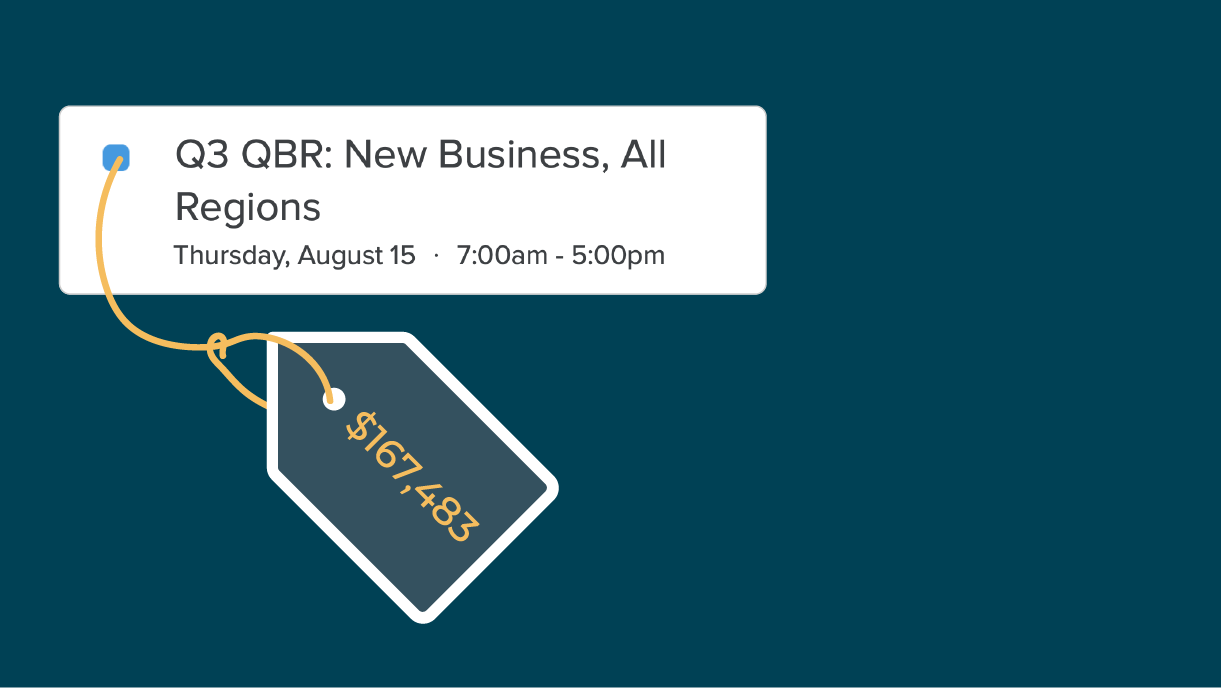The Massive, Untapped 2024 Revenue Opportunity: How to Drive These 3 Sales Velocity Metrics
I got a series of DM’s from sellers over the holiday week, all saying similar things:
- They closed their companies’ biggest deals this year.
- While rapidly increasing average deal size.
- And also shrinking sales cycles.
Here’s a screenshot of one as an example:
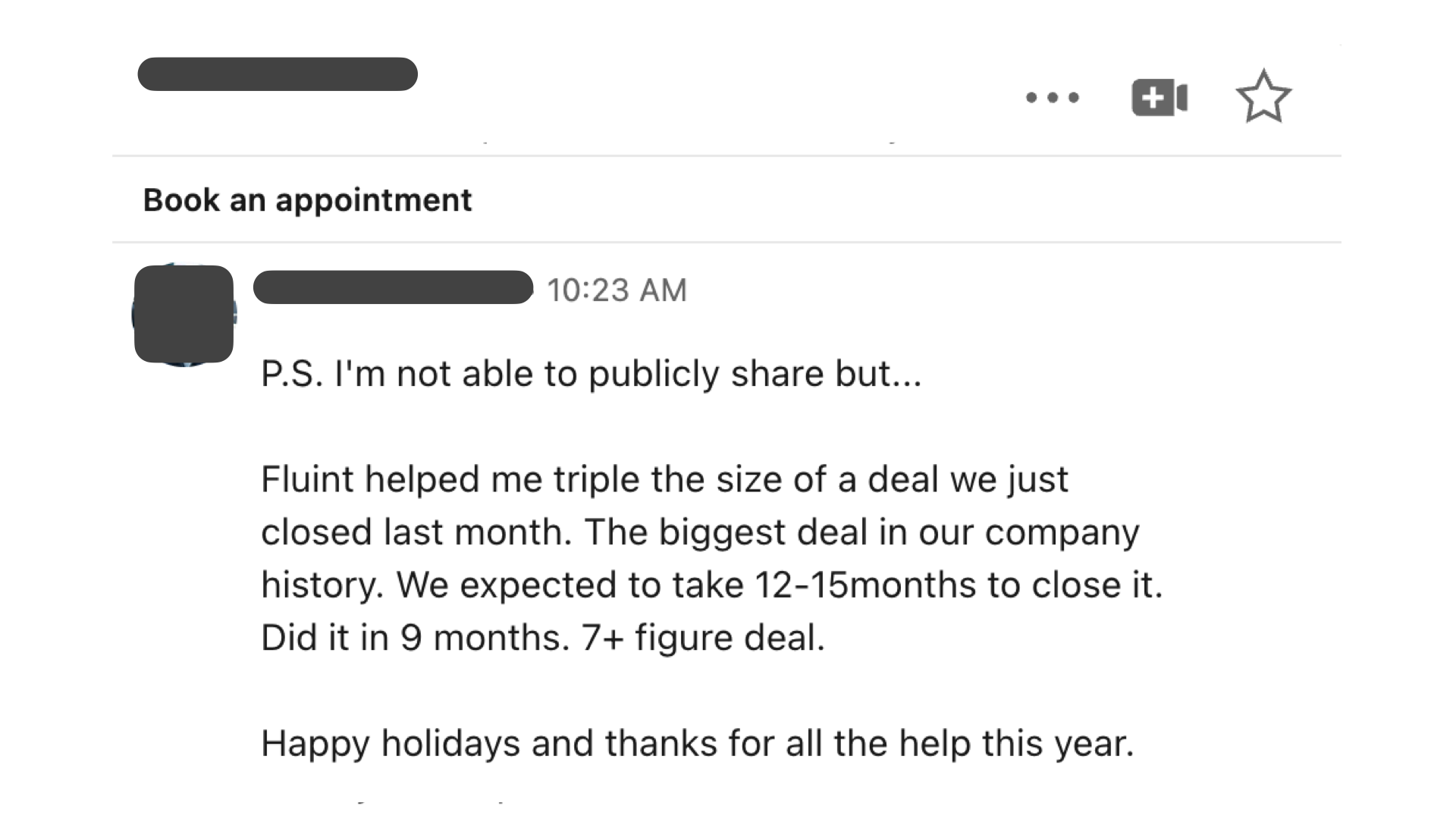
Now, here's the thing to notice in this DM. Which we'll break down in the rest of this post.
Their business case tapped into 3 out of 4 metrics that make up sales velocity:
- Win Rate: Winning complex deals.
- Average Contract Value: Winning larger, complex deals.
- Sales Cycle Time: Winning larger, complex deals, faster.
Here's a nice visual of the full formula from our friends at HubSpot:
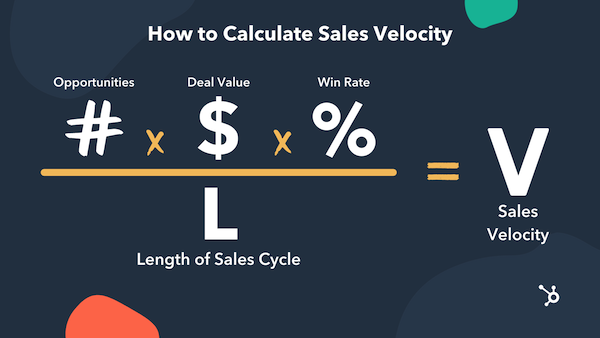
And before you start thinking...
“...well that’s a nice story Nate, a 7-figure deal. But I’m a SMB / Commercial rep...”
...here's another example. From a seller with an SMB title, yet he closed a deal so big, they announced it in this press release.
Your Massive, Untapped Revenue Opportunity in 2024
So what’s the common thread between all these stories? Their “secret”?
Building business cases.
The highest-impact, yet most-overlooked approach to driving sales velocity:
(1) It’s high-impact, because it’s the one approach that ties together every:
- Downstream Metric: Win Rate, ACV, Cycle Time.
- Upstream Metric: Stage-to-Stage Conversion Rates, Seller:Buyer Activity Ratio, Minutes Spent "Above the Line."
(2) It’s overlooked, because most teams only have a business case for 5% - 10% of their pipeline.
- If you look at your pipeline, what % of deals actually have a business case?
- My guess is it's a similar range. Even if you have a full Value Engineering function.
Which makes this the massive, untapped opportunity in most revenue orgs.
(Unless you're overflowing with pipeline and winning by sheer volume of qualified opportunities. The 4th metric in the formula above.)
So let's break down 3 shifts you can make in your sales process — all enabled by building business cases — to drive sales velocity.
We'll primarily focus on “upstream” metrics, because they're inputs while downstream metrics are outcomes. So focusing on the upstream changes creates the results we want downstream.
As an aside, you could consider this “Part 2” to why the business is the sales process.
So if you haven't read that yet, I'd check that one out too.
3 Sales Process Shifts to Drive Your “Upstream” Metrics
1/ Build a Business Case Now, Not Later, to Drive Stage-to-Stage Conversions
The big mistake to avoid is thinking a business case is part of “closing” a late-stage deal.
Versus progressing a deal to that late stage in the first place.
Here's an example of what I mean:
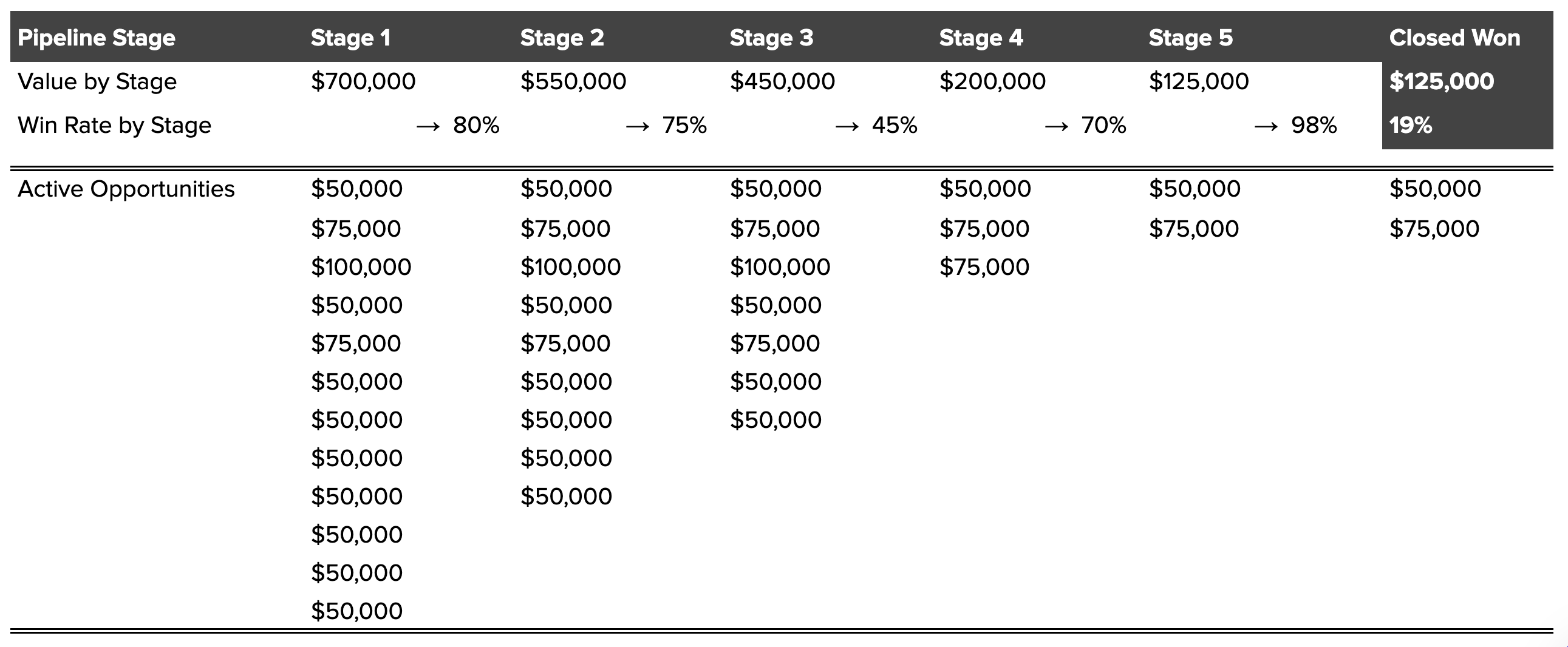
When you look at this rep's overall 19% win rate, you realize two things:
- Two reps can have the same # of opportunities with very different weighted pipelines (based on win rates).
- Their win rates the (downstream metric) is the sum of every stage-specific win rate (upstream metric).
With this in mind, here’s the shift in process.
Before:
- Reps build a business case or bring in a Value Engineer to “close” a late-stage deal.
- But if you know deals with a business case close at a higher rate than those without, why wait to boost win rates?
After:
- Start building your business cases after the very first call.
- Which drives up your stage-to-stage conversion rates.
In the example here, this rep would see increased Stage 3 → 4 and 4 → 5 win rates with deeper discovery — and business case drafts are how you’ll find and fill discovery gaps.
Now, practically speaking, how do you build out your process around this?
→ You tie pipeline stages to business case development.
Expect to start off with a simple draft to identify gaps, then, build it out over time:

Which implies there's a way to score if the business case is strong enough to move into the next stage.
So just like you'd use a scorecard for call reviews, you can do the same with business cases.
Here's a framework you can use, ASAP: grab it here. It's based on the 1-Page Business Case.
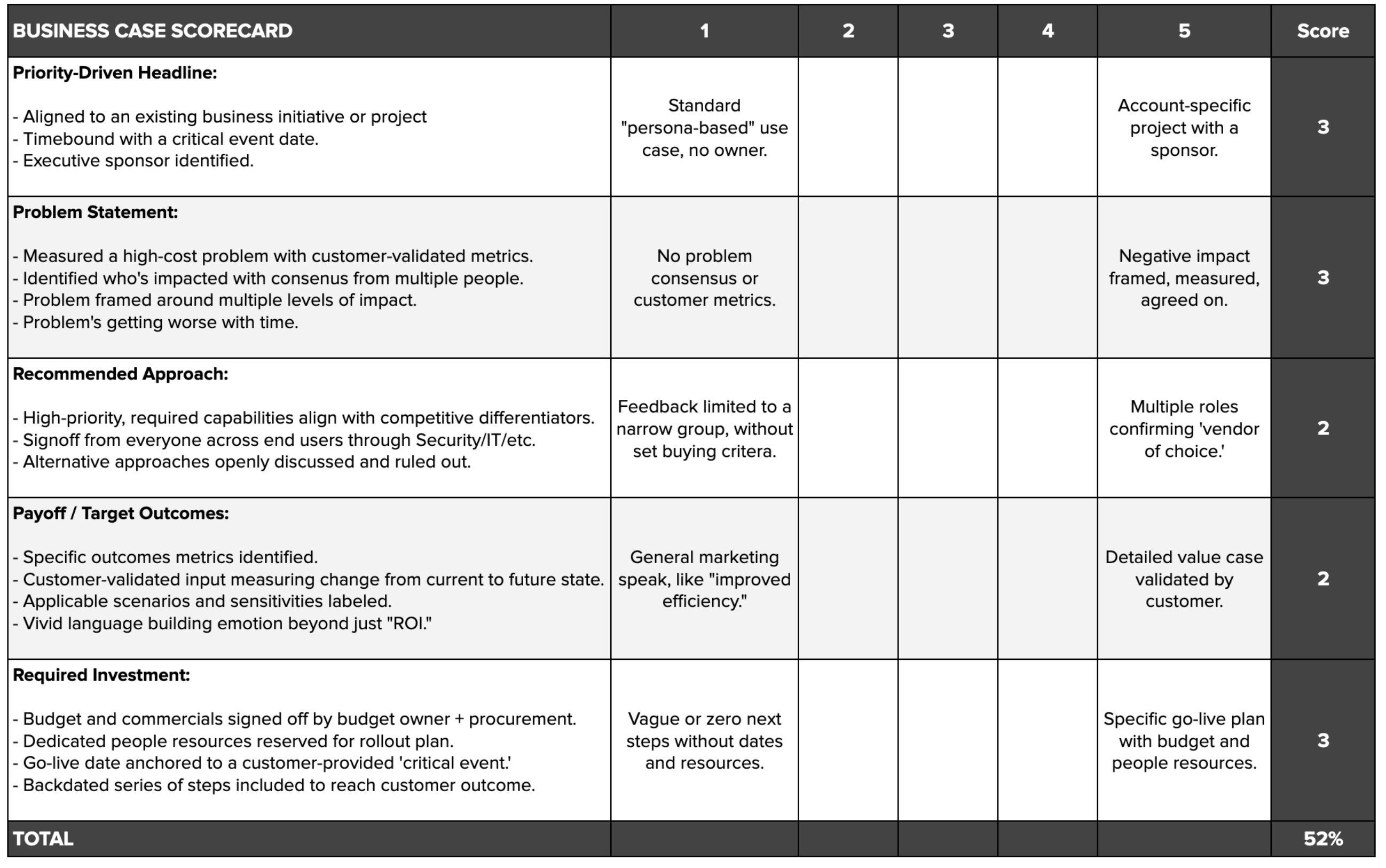
By the way, this ties back into the ideas that:
- The business case is the sales process.
- Pipeline stages should be aligned with buying behavior, not seller behavior
- Everyone in the revenue org benefits from making this shift:
- Sellers: A roadmap for identifying and filling deal risk alongside champions.
- Leadership: Grounds forecasts & deal reviews in the reality of where deals are.
- Enablement: Identifies skill gaps for deeper training & learning content.
- Value Engineers: Setting the standard for “what good” looks like beyond an ROI model.
- SalesOps: Gates deal progression until minimum standards met, to keep clean data.
- Customer Success: Written recap of what’s been promised and planned with the customer.
And, because this process is based on:
- Written content
- Buying behaviors
Everyone can see what’s actually been created at any given time in a deal. It’s tangible.
So much so, you shouldn’t need point-in-time QBR’s to assess true pipeline health.
Just open up the written business case, and it'll be glaringly obvious.
(2) Narratives vs. ROI, to Increase Seller:Buyer Activity Ratio
Too many sales leaders will look at a long list of activities inside an opportunity and think, “Wow, they’re all over this one. Nice job!”
While totally overlooking how lopsided the activity is. Those 10 emails and calls to a Stage 3+ deal… got a single email reply.
That’s it. A 10:1 ratio. Which is pretty scary, because:
- The deal was clearly de-prioritized by the buyer.
- Their message didn’t land, so buyers think, “why spend time on this?”
Compare that to a 2:1, or even 1:1 activity ratio for deal in the same stage?
I’m putting my money (and reputation) on the more even, 2:1 ratio.
So the question is, how do you dial up this activity ratio?
By crafting an engaging narrative that keeps the deal prioritized with:
- Multithreaded input. More people inside a deal drives more buying-side activities. So as the # of engaged contacts per deal goes up, so does your activity ratio.
- Exec alignment. Before you can multithread, you need to hook and hold attention, which comes with messaging that aligns with a priority everyone's already sold on.
A simple storyline inside your business case, built with your buyer’s own words, will do this by “traveling” around the buying team:
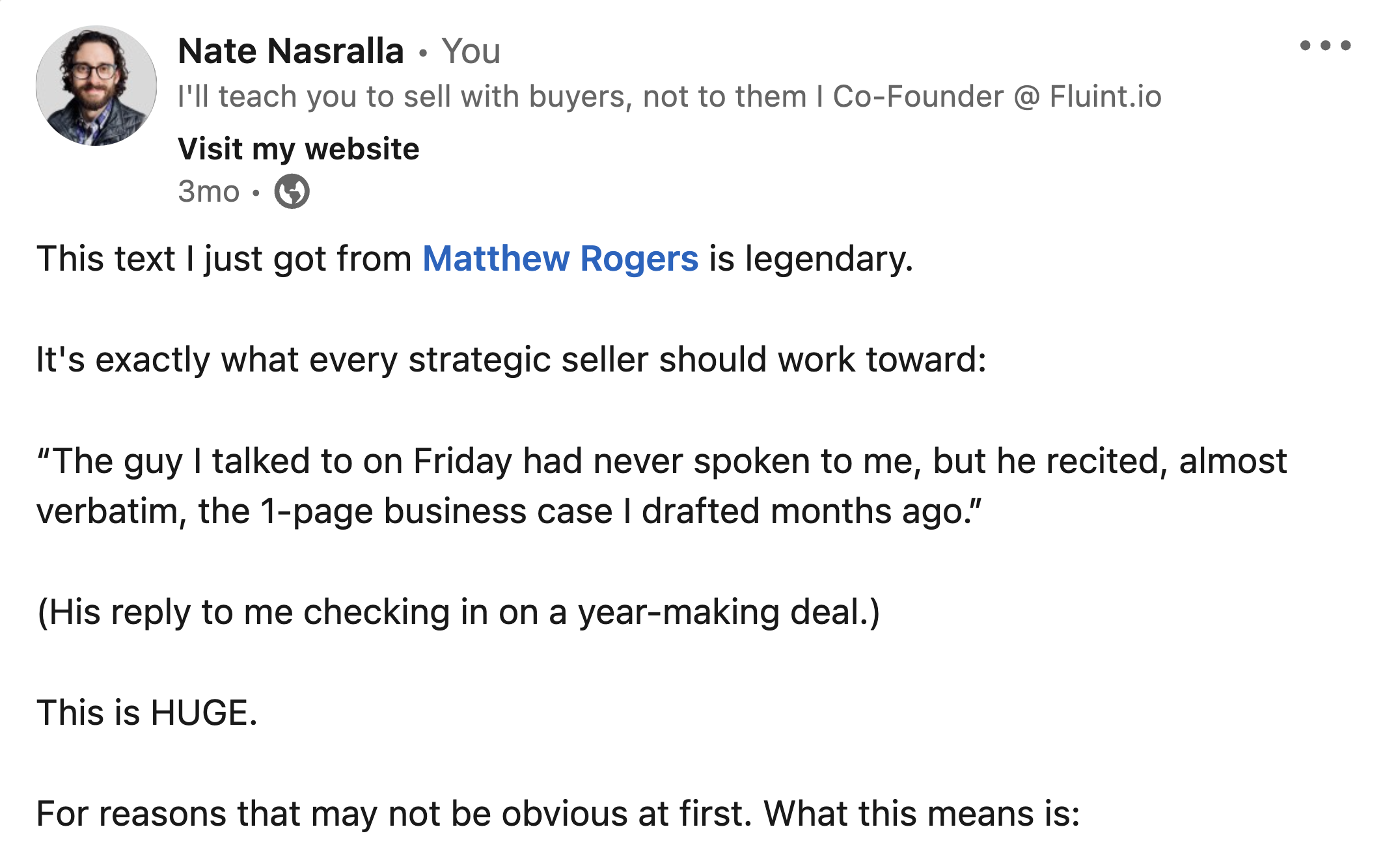
Whereas ROI models and the typical product deck won’t hold attention.
Here's some interesting data on this from our friends at Gong:

(3) Engineering vs. Enablement, to Increase Minutes Above vs. Below the Line
If you’re working on building a Value Engineering function, you’re probably one of the few people still reading to the end of this post.
And if I had to guess, you might be asking questions like:
- How do we increase deal coverage?
"We work on a fraction of the pipeline, focused on high-priority deals. How do we impact more of them?”
- How do we increase buying team engagement?
"We get called into deals late, and it’s a struggle to get data from the customer, or get executive attention on what we build.”
For example: you’re involved in 5 out of 50 deals. You spend weeks tracking down customer inputs. Then days building a bulletproof ROI model / BVA sheet….
…and the CFO never even opens it.
The answer to both of those points is blending enablement with engineering.
Because you can impact every deal without having to be involved in every deal, by:
- Sponsoring the process changes outlined in point 1.
- Evaluating tech to increase coverage.
- Leading skills training for reps.
It's an approach that will start to blur the lines between enablement and engineering, as you create the training, tech, and process to shift the way your team goes to market for every deal. (Not just the ones you touch.)
So, what’s the main, upstream metric that signals you’ve done this successfully?
- Sellers are spending more time “Above the Line” by Stage 2.
- Engaging with exec sponsors early, by working with tested champions.
No more “we’ll get exec buy-in at Stage 5" type deals.
All 3 of these shifts in process and upstream metrics are a big part of what Fluint enables.
For example, watch from minute 2:00, here. You'll see how, in this next screenshot, there's:
- Right side: a draft business case Fluint wrote early in the deal, based on available inputs.
- Left side: a business case score with gaps + discovery suggestions called out.

If you're curious to see how Fluint can help, drop me a line at nate@fluint.io.
Why stop now?
You’re on a roll. Keep reading related write-up’s:
Draft with one click, go from DIY, to done-with-you AI
Get an executive-ready business case in seconds, built with your buyer's words and our AI.

Meet the sellers simplifying complex deals
Loved by top performers from 500+ companies with over $250M in closed-won revenue, across 19,900 deals managed with Fluint

Now getting more call transcripts into the tool so I can do more of that 1-click goodness.



The buying team literally skipped entire steps in the decision process after seeing our champion lay out the value for them.


Which is what Fluint lets me do: enable my champions, by making it easy for them to sell what matters to them and impacts their role.





.png)


